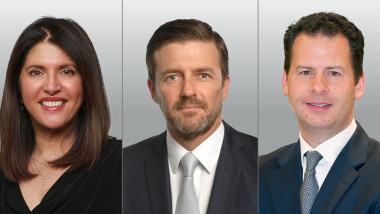How Cities Use Finance to Manage Climate Change
Urbanisation, ageing populations, and climate change are piling pressure on cities around the world to adapt, and the solutions require both changes in public policy and innovative private sector investment.
One problem is that the minerals made to construct many cities are unfortunately very good at absorbing the heat of the sun during heatwaves, turning them into ‘heat islands’ and causing a rise in temperature and air pollution. Pollution and heat waves kill – as American sociologist Eric Klinenberg, a specialist on the social impact of heat waves, summed up: “Heatwaves are silent and invisible killers of silent and invisible people, especially the oldest and most fragile.”3
Researchers at the Department of Environmental Systems Sciences in Zurich, Switzerland, have calculated that 22% of the world’s 500 largest cities will experience previously unknown conditions in 2050.4 Higher temperatures and less precipitation could be the new standard for cities in Southeast Asia, for instance.4
Take Manila, the capital city of the Philippines, which will be nearly 4°C warmer on average during the summer yet will also experience 8% less rain in an average year. The PLOS-One study predicts that the climate of Madrid in 2050 will resemble that of Marrakech today; London will be more like Barcelona today.5
Transport and buildings within these urban areas – whether residential, commercial or industrial – are responsible for nearly 75% of global CO2 emissions and have a major impact on the environment.6 That’s why the most advanced cities are developing planning tools and engaging both mitigation and adaptation policies.
Of course, these policies come with a cost attached. Yet the cost of adaptation is still much lower than the perceived cost of climate inaction and repairs, which could undermine the economy.7
Finance therefore clearly has a role to play in helping cities mitigate and adapt to the consequences of climate change. Here are three examples of investments that aim to make a difference:
Renovation is a priority for cities with public buildings such as schools, hospitals, universities, and social housing. Inflation, coupled with the soaring cost of energy, can plunge the occupants into financial and energy poverty.
Nevertheless, practical solutions exist. For instance, to limit excessive indoor temperatures during heatwaves – and limit the use of air conditioning where possible – offices or warehouses can resort to night over-ventilation. This passive technique captures cooler outdoor air at night and infuses it inside to lower the indoor temperature.
As Thierry Laquitaine, SRI Director at real estate investment specialist AEW, explains: “Coupled with better insulation avoiding overconsumption in winter and the use of air conditioning in summer, over-ventilation could contribute to limiting energy consumption.”
There’s the physical risk of climate change on real estate assets, and AEW has systematically integrated climate risk analysis into its portfolios since 2020. For example, buildings can experience flooding due to excessive rainfall. That’s where the installation of non-return valves can prevent the intrusion of flood water into the dwellings by blocking the reflux of wastewater at the toilet or sinks.
Climate-related risks also include subsidence in clay soils. If clay is subjected to frequent droughts and floods it expands and contracts, damaging the foundations and structure of buildings. AEW has a team dedicated to the ESG management of their portfolio which applies ESG analysis at all stages of the real estate project – from acquisition to construction to renovation.
Thierry comments: “We have developed our own assessment process to accurately map the climate risks to which our assets are exposed. This allows us to assess their vulnerability and implement an appropriate action plan.
“An effective action plan requires that all AEW teams are involved – including the investment and asset management teams and the technical departments. We have provided substantial training for our teams in different countries. Everyone must have sufficient knowledge to have right reflexes to address climate risks.”
Moreover, combating climate change means continually evolving. “This is not a one-shot project,” adds Thierry. “Our data, analysis and tools need to be updated frequently. Scientists are being drawn to this area of expertise and knowledge of climate change is improving fast. We all need to adapt our knowledge and keep pace with these changes.”
The ambitious objectives of the European Union to reduce greenhouse gases (-55% by 2030 and carbon neutrality by 2050) fuel the objectives of green bonds to support everything from the electrification of transport to the development of renewable energies or the improvement of the energy performance of buildings.9
Meanwhile, sustainable bonds – which include a broader remit than green bonds – accounted for 15% of total primary bond issues in the world in 2023.10 Local authorities have joined the ranks of green bond issuers, a market initially dominated by sovereign states, supranationals and agencies, to finance local transition policies.
To reduce urban pollution, cities encourage the development of soft mobility – cycling, walking, scooters – and public transport. In Paris, for instance, the Grand Paris Express (the Paris metro) aims to extend metro lines in the Paris region by 2030.11
This project is financed in part through green bonds underwritten by sustainable investment specialist Mirova, which ensures that the money paid is well signposted to the Grand Paris Express in accordance with the Green Bond Principles. Traceability and transparency of such a green bond project also reduces any fears about ‘greenwashing’.
Marc Briand, co-head of Fixed Income at Mirova, says: “Green bonds are a great way for investors to have transparency over their portfolio, so they can see how their money is invested from an ESG impact perspective. Moreover, we pay extra-close attention to the level of detail and transparency of the impact reporting provided for every project we consider.
“The bond from the Société du Grand Paris will finance the construction of four new automated metro lines – approximately 200 km in length – and the extension of existing lines, in addition to the construction and development of 68 new metro stations and seven technical centres. The project is expected to benefit two million passengers per day and lead to the creation of 15,000 direct jobs per year.”12
The infrastructure sector has often been criticised for its seemingly inexhaustible consumption of materials and greenhouse gas emissions,13 yet this sector is essential in our day-to-day societal activities and is therefore ripe for innovation and adaptation.
Vauban Infrastructure Partners believes that infrastructure must embrace a revolution and move from a linear to a circular model. To support this commitment, Vauban has taken a stake in Indigo, a leader in parking and individual mobility that is shifting its business strategy to provide charging stations for electric vehicles and self-service bicycles in its car parks, and partnering with last-mile distribution players.14
Mounir Corm, Deputy CEO & Founding Partner of Vauban Infrastructure Partners, explains: “Climate change solutions are emerging, and being able to scale them will be the key to success. With 80% of the global population concentrated in urban areas in 2050, these cities – where infrastructure is interconnected – will have a central role to play, which is incubating, without delay, the circular revolution.”
For example, innovative ‘blended finance’ approaches use public funds or government support to encourage private investment, the result of which can finance projects or businesses that, under normal circumstances, would be considered ‘un-investable’. Governments effectively provide a safety net – their co-investments and guarantees unlock private investment by lowering risk or enhancing returns and, in many ways, transform the ‘un-investable’ into the ‘investable’.
Pooling resources means more investment at scale. Most importantly, money goes to the areas that need it most: to help in the fight against climate change and biodiversity loss, and to build better, more sustainable livelihoods for local communities.
When it comes to helping cities manage climate change today, and in the future, all financial paths to progress need to be carefully considered.
AEW, Mirova and Vauban Infrastructure Partners are all affiliates of Natixis Investment Managers, and form part of our Expert Collective.
2 In 2018. (from 30% in 1950 to 55% in 2018, 2050 is forecast to be 70% urban. UN, "68% of the world’s population should live in urban areas by 2050,
according to the UN ".
3 Philosophie magazine, July 2022, https://www.philomag.com/articles/eric-klinenberg-les-canicules-sont-des-tueuses-silencieuses-et-invisibles-de-personnes
4 https://www.weforum.org/agenda/2022/06/climate-change-cities-experience-climate-extremes/
5 https://journals.plos.org/plosone/article?id=10.1371/journal.pone.0217592
6 UNEP, Cities and Climate Change
7 https://www.un.org/en/climatechange/thought-leaders-simon-stiell
8 https://commission.europa.eu/news/focus-energy-efficiency-buildings-2020-02-17_en
9 As defined in the Green Bond Principles https://www.icmagroup.org/assets/documents/Sustainable-finance/2022-updates/Green-Bond-Principles-June-2022-060623.pdf
10 Mirova/Bloomberg
11 https://www.grandparisexpress.fr/gpe-essentiel
12 Mirova Research
13 63% of global material consumption and 79% of greenhouse gases
14 Vauban, ‘Investing in a sector essential for a circular economy’, https://www.im.natixis.com/en-institutional/insights/vauban-infrastructure-partners-car-park-management-strategy
The provision of this material and/or reference to specific securities, sectors, or markets within this material does not constitute investment advice, or a recommendation or an offer to buy or to sell any security, or an offer of any regulated financial activity. Investors should consider the investment objectives, risks and expenses of any investment carefully before investing. The analyses, opinions, and certain of the investment themes and processes referenced herein represent the views of the portfolio manager(s) as of the date indicated. These, as well as the portfolio holdings and characteristics shown, are subject to change. There can be no assurance that developments will transpire as may be forecasted in this material. The analyses and opinions expressed by external third parties are independent and does not necessarily reflect those of Natixis Investment Managers. Past performance information presented is not indicative of future performance.
DR-62595




 Global Corporate Bonds – Attractive Yields but Thin Risk Premium
Global Corporate Bonds – Attractive Yields but Thin Risk Premium
 Private assets: Is regulation a brake or an accelerator?
Private assets: Is regulation a brake or an accelerator?

 All back to bonds?
All back to bonds?